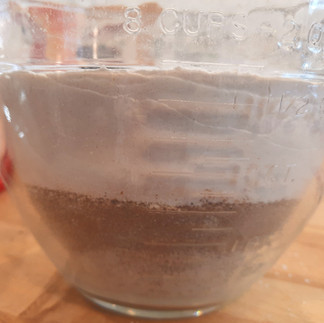Irish Soda Bread
- Tracy Scheckel
- Mar 8
- 4 min read

Growing up, if my one Irish grandmother made soda bread, it was not memorable, nor was what came from the bakeries; therefore, I was indifferent to it. That is, until I got involved in a cookbook fundraiser; I'll not forget the first bite I had of Pat Sheridan's Irish Soda Bread; the crust was crunchy and sweet and inside was moist and had plenty of raisins.

I started my own tradition of making that recipe every year for St. Patty's Day and it was met with accolades by everyone who tasted it -- until I made it for my husband John. He spent a summer in Ireland before his senior year in college and I thought I would surprise him with a trip down memory lane with what I thought was as traditional as it gets. Well, I was wrong, and not just about the soda bread, but the whole boiled dinner corned beef and cabbage thing. Apparently, John never ate any corned beef while he was there - just lots of lamb. And as for the soda bread, what he described was much more rustic and less sweet than Pat's recipe. So, loving a challenge, I started tweaking the recipe based on John's critique each year. The recipe I'm sharing is the latest, but is always subject to tweak here and there as he always seems to have more suggestions .
In preparing to write this post I looked for a definitive explanation about Irish soda bread and its origins and basic recipe. What I found was a bunch of cooks, chefs, and food bloggers venturing their opinion on the origins of the celebrated Irish soda bread.

Then I came across the Society for the Preservation of Irish Soda Bread which is also brought to us by a chef and author, Ed O’Dwyer, but it sounds SO much more official. If you REALLY want to go down a rabbit hole, check out his site. The crib note version is that Irish soda bread originated when baking soda was first introduced to the UK in the 1830s, as a cheap nourishing food during the potato famine. It was made by mixing a simple dough with just 4 ingredients:
flour
salt
baking soda
buttermilk
The acidity of the buttermilk reacting with the baking soda provided the leavening. Unlike modern and American versions, the original recipes had no eggs, butter, raisins, or sugar.

Beyond that, there are also regional variations between Northern and Southern Ireland; in the north, the bread called farls (fourths) is shaped into 4 triangles and cooked on a griddle on top of the stove; in the south the loaf is round with an X or a cross cut into the top. In practice, cutting an into the top of a loaf, allows steam to escape and helps it rise more evenly, but lore has it that it was a nod to Catholic faith and the Gaelic Cross.
The recipe I'm sharing here is not the 4 ingredient traditional loaf of the 19th century, nor is it the sweet version that Pat shared for that charity cookbook. It is basically the evolution of 30 or so years trying to get to what my husband remembers from his summer on the Emerald Isle.
Note that the recipe below is for one loaf, the photos are for a double recipe that I prepared to see if there's a difference between baking in cast iron and a regular baking pan. Short story on that, bot really.
For a full on St. Patty's Day menu, make some Irish Cream and potato candies!
THE RECIPE:
1-1/2c buttermilk
3/4c spent grain flour (you can increase rye and add whole wheat is you don't have any spent grain kicking around) to get to the 3/4 cup)
1/2c course oat flour
1/8c rye flour
1/2c (after grinding) ground tri-color quinoa see note at the end of the recipe
White flour enough to bring the flour blend to 3-1/3 cups
1t salt
1t baking soda
1T baking powder
1 egg beaten
Preheat Oven to 400 degrees
Combine the flours adding just enough white flour to get to 3-1/2 cups
Whisk in the remaining dry ingredients
In a separate bowl whisk eggs and buttermilk together
Use a fork to blend the liquid into the flour but don't over mix. It should be a bit shaggy.
Line a 9" round pan or cast iron skillet with parchment and scrape the batter into the pan.
Dust some flour on the top and score an X with a sharp knife.
Bake 35-50 minutes until toothpick comes out clean.
Don't have buttermilk? Mix 1c milk with EITHER 1T lemon juice OR 2T cider or white vinegar, give it a gentle stir and set aside for 10 minutes. You'll see it curdle a bit and then you have a buttermilk substitute.
Quinoa flour: Take quinoa and grind it in a blender until it's the consistency of course flour.
Oat flour substitute: I've used either rolled or steel-cut oats and ground them in the blender when I didn't have or couldn't find oat flour.









































